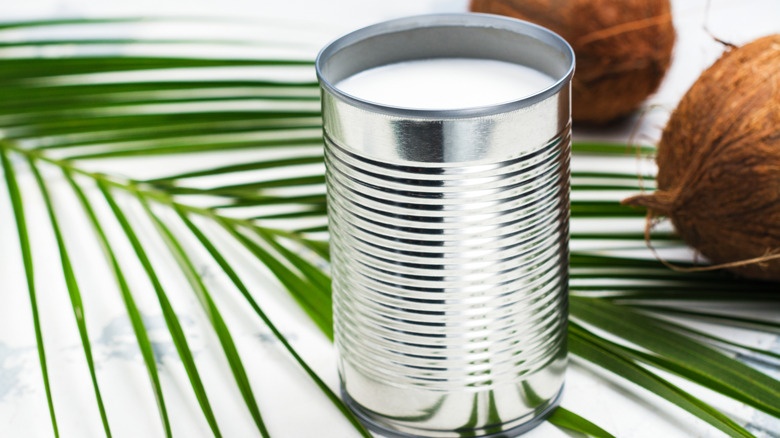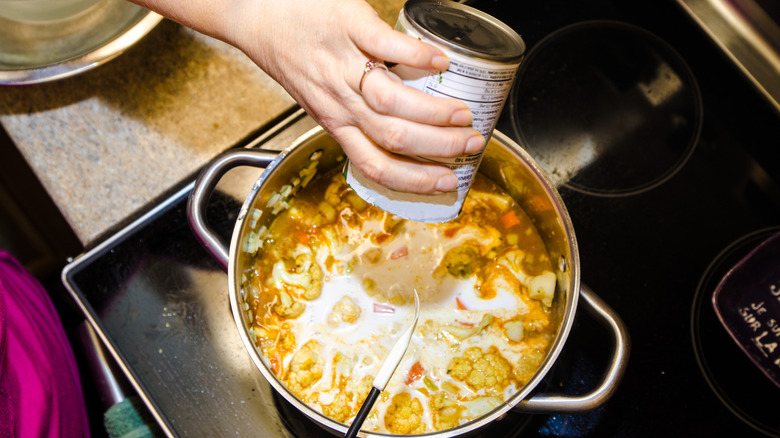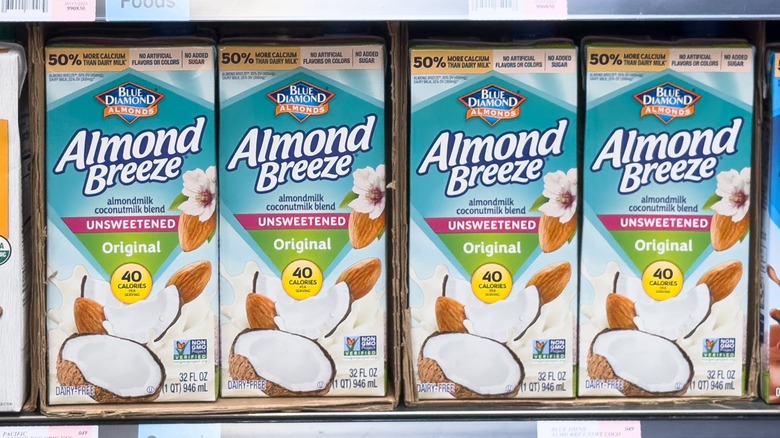When To Cook With Canned Vs Boxed Coconut Milk
Few food items compete with the versatility of coconut milk. Used in both sweet and savory dishes across Asia, Africa, and Latin America, it's a rich addition that ties wide-ranging ingredients together. Nothing compares with coconut's wondrously aromatic qualities in fresh form. However, squeezing the milk out of grated coconut is labor-intensive, and the result spoils quickly, making it difficult to distribute. So, outside of tropical areas, it's nearly always processed. Store bought coconut milk is pasteurized, and varying additives are introduced for stability before packaging it into either a can or box.
Although both types bear the same coconut milk moniker, they're actually different in composition, and come with distinct culinary uses. The canned version is up to eight times higher in fat, and contains guar gum as a stabilizer. On the contrary, the carton is much more watery, and comes with a larger range of additives like sugar, salt, minerals, and other preservatives. Built for enjoyable drinkability, its function is quite a contrast to the creamy culinary predisposition of the canned version.
Meld components with the richness off canned coconut milk
Canned coconut milk's biggest advantage is its fat content. Rich and thick, it's the go-to product for thickening curries, stews, soups, and more. Such a texture helps meld a kaleidoscope of flavors across cuisines. In Southeast Asian dishes, it'll form a foundation for fragrant panang curry (perhaps riffed into a panang tomato bisque), or lend richness to a bowl of laksa. South Asian recipes will use it to thicken a legume-based dal or marinade and simmer fish for Meen Kulambu. In the Caribbean, it's a dose of extra fat and flavor for rice and peas or the body in Moqueca, a Brazilian seafood stew. Needless to say, its applicability covers quite a range; with its heavier nature tying it all together.
Simmering is an especially common technique: Slow and patient cooking will prevent burning and allow ingredients to meld. However, you'll also see canned coconut milk in raw applications like cheesecake which employs chilling for thickening. Regardless of the precise technique, you'll likely want to go for the full-fat version, as this will achieve optimal richness.
Note that especially for brands with minimal preservatives, canned coconut will separate, with the fattier portion coming up to the top of the can. You can even use that cream in canned milk for dedicated purposes, or simply shake the can beforehand. And take note that coconut milk does go bad after a few years on the shelf. Before any recipe, double check the expiration date.
Boxed coconut milk is a dairy substitute
Boxed coconut milk is quite a different creation — the fattiness is severely reduced with the introduction of water, and flavorings are incorporated to create a desirable palate. Rather than the foodstuff for crafting curry, this product is meant as a type of alternative milk. As a result, vitamins and minerals are introduced to mirror the health benefits of dairy. So, when you see the boxed form, think using it like a classic milk carton. And if you see coconut milk in the fridge held in any container, that's another sign the product is intended for drinking enjoyment.
Most often, this type of coconut milk is employed in applications similar to cow milk. It's a terrific liquidy base for a smoothie, coconut-flavored lemonade, or even an iced coconut coffee. Alternatively, freeze it into a delicious shaved ice. Or for an extra-easy treat, prepare a bowl of cereal with boxed milk. Additionally, some baking applications favor the less intense flavor and watery consistency, especially if compounded with other forms of coconut.
Mimicking the box version with the can is easy; simply dilute the fattier variant with water, and perhaps add some sugar for flavor. However, the other way around is much trickier; generally, purchase canned coconut milk for maximum versatility.


